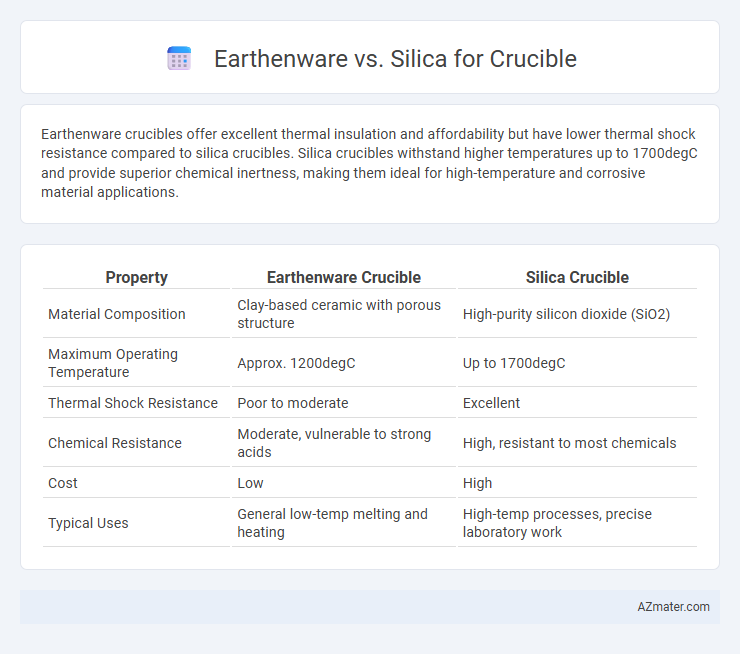Earthenware crucibles offer excellent thermal insulation and affordability but have lower thermal shock resistance compared to silica crucibles. Silica crucibles withstand higher temperatures up to 1700degC and provide superior chemical inertness, making them ideal for high-temperature and corrosive material applications.
Table of Comparison
| Property | Earthenware Crucible | Silica Crucible |
|---|---|---|
| Material Composition | Clay-based ceramic with porous structure | High-purity silicon dioxide (SiO2) |
| Maximum Operating Temperature | Approx. 1200degC | Up to 1700degC |
| Thermal Shock Resistance | Poor to moderate | Excellent |
| Chemical Resistance | Moderate, vulnerable to strong acids | High, resistant to most chemicals |
| Cost | Low | High |
| Typical Uses | General low-temp melting and heating | High-temp processes, precise laboratory work |
Introduction to Crucible Materials
Crucibles are essential for high-temperature applications in laboratories and industries, and their material composition significantly impacts performance and durability. Earthenware crucibles, made from natural clay, offer affordability and moderate heat resistance but may be prone to thermal shock and limited chemical inertness. Silica crucibles, consisting of high-purity silicon dioxide, provide superior thermal stability, corrosion resistance, and can withstand extreme temperatures, making them ideal for demanding processes such as metal melting and chemical synthesis.
What is Earthenware?
Earthenware is a porous ceramic material made from natural clay, fired at relatively low temperatures between 1,000degC to 1,150degC, making it suitable for crucibles used in low-heat applications. It offers good thermal insulation but lacks the high resistance to thermal shock and chemical corrosion found in silica crucibles, which are made from high-purity silicon dioxide and fired at temperatures exceeding 1,600degC. Earthenware crucibles are ideal for melting metals with lower melting points, while silica crucibles are preferred for high-temperature processes due to their superior durability and chemical inertness.
Properties of Earthenware Crucibles
Earthenware crucibles feature high porosity and relatively low thermal shock resistance, limiting their use to temperatures typically below 1100degC. Made from natural clays, they exhibit moderate mechanical strength but are more susceptible to cracking under rapid temperature changes compared to silica crucibles. Their affordability and ease of molding make them suitable for low-temperature metal melting and general laboratory applications where ultra-high heat resistance is not essential.
Overview of Silica Crucibles
Silica crucibles are highly valued in high-temperature laboratory applications due to their excellent thermal stability, resistance to thermal shock, and inertness to most chemical reactions. Unlike earthenware crucibles, silica crucibles can withstand temperatures exceeding 1,700degC, making them ideal for processes such as metal melting and glass production. Their purity and structural integrity provide superior performance in precise analytical and industrial procedures.
Thermal Stability Comparison
Earthenware crucibles exhibit moderate thermal stability, with a maximum operating temperature typically around 1100degC, making them suitable for low to medium-temperature applications. Silica crucibles demonstrate superior thermal stability, withstanding temperatures up to 1700degC and exhibiting excellent resistance to thermal shock and deformation. This enhanced thermal endurance of silica makes it ideal for high-temperature processes such as metal melting and chemical analysis.
Chemical Resistance: Earthenware vs Silica
Earthenware crucibles exhibit moderate chemical resistance, suitable for low to medium temperature applications but prone to corrosion by strong alkalis and acids. Silica crucibles offer superior chemical inertness, with exceptional resistance to acidic and alkaline environments and minimal reactivity at high temperatures up to 1700degC. The high purity and crystalline structure of silica make it ideal for processes requiring consistent chemical stability and resistance to thermal shock.
Cost Efficiency and Availability
Earthenware crucibles offer cost efficiency due to lower material and manufacturing expenses, making them widely accessible for basic high-temperature applications. Silica crucibles, though more expensive, provide superior thermal resistance and durability, which reduces replacement frequency and operational interruptions. Availability of earthenware is generally higher in local markets, while silica crucibles may require specialized suppliers, impacting procurement lead times.
Common Applications in Industry
Earthenware crucibles are widely used in traditional metallurgy and pottery industries due to their affordability and thermal resistance for melting non-ferrous metals and ceramics. Silica crucibles serve critical roles in the glass manufacturing and semiconductor sectors, offering superior thermal shock resistance and purity required for high-temperature processes. Both materials provide essential functions based on their chemical stability, temperature range, and interaction with specific molten substances in varied industrial applications.
Environmental Impact and Sustainability
Earthenware crucibles, made from natural clay materials, generally have a lower carbon footprint due to their energy-efficient firing processes and biodegradability, promoting environmental sustainability. Silica crucibles, composed of high-purity quartz, require energy-intensive production and mining, leading to higher environmental impact despite their durability and resistance to thermal shock. Choosing earthenware supports eco-friendly manufacturing and waste reduction, while silica offers longevity, potentially reducing resource consumption over multiple uses.
Choosing the Right Crucible Material
Selecting the right crucible material depends on the specific thermal and chemical requirements of the process. Earthenware crucibles offer excellent thermal insulation and are suitable for low-temperature applications but may degrade under rapid temperature changes and aggressive chemicals. Silica crucibles provide superior thermal shock resistance and high purity, making them ideal for high-temperature melting and applications requiring clean, contamination-free conditions.

Infographic: Earthenware vs Silica for Crucible
 azmater.com
azmater.com